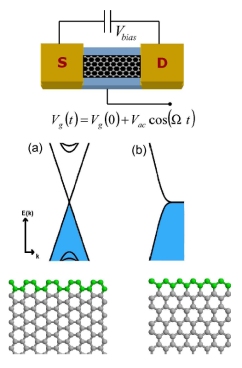We report on a theoretical study of the effects of time-dependent fields on electronic transport through graphene nanoribbon devices. The Fabry-Perot interference pattern is modified by an ac gating in a way that depends strongly on the shape of the graphene edges. While for armchair edges the patterns are found to be regular and can be controlled very efficiently by tuning the ac field, samples with zigzag edges exhibit a much more complex interference pattern due to their peculiar electronic structure. These studies highlight the main role played by geometric details of graphene nanoribbons within the coherent transport regime. We also extend our analysis to noise power response identifying under which conditions it is possible to minimize the current fluctuations as well as exploring scaling properties of noise with the length and width of the systems.

We report on a theoretical study of the effects of time-dependent fields on electronic transport through graphene nanoribbon devices. The Fabry-Perot interference pattern is modified by an ac gating in a way that depends strongly on the shape of the graphene edges. While for armchair edges the patterns are found to be regular and can be controlled very efficiently by tuning the ac field, samples with zigzag edges exhibit a much more complex interference pattern due to their peculiar electronic structure. These studies highlight the main role played by geometric details of graphene nanoribbons within the coherent transport regime. We also extend our analysis to noise power response identifying under which conditions it is possible to minimize the current fluctuations as well as exploring scaling properties of noise with the length and width of the systems.
